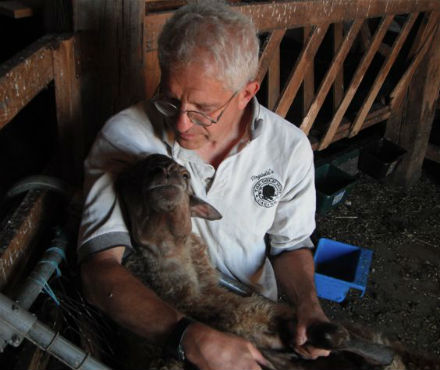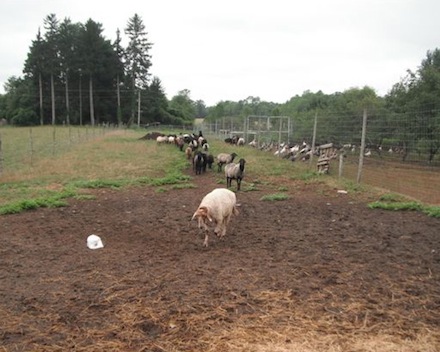AgriCulture bloggers Peter Davies and Mark Scherzer are the owners of Turkana Farms in Germantown, NY. This week Mark writes.

Under siege. Or so it seems. There are enough things that have to get accomplished on the farm this season, all simultaneously, that sometimes it seems your head could explode. One night last weekend, around 1:30 a.m., I had a Lucy in the Chocolate Factory assembly line moment, when I was simultaneously boiling some raspberry jam on the stove and, in another pot, the jars to seal it in, washing eggs, defrosting the freezer and trying to unclog a sink, in the middle of which I suddenly remembered I had to run out and close the hatch on the chicken coop and feed the baby freedom rangers, a late group we started to compensate for the loss of two thirds of our first batch of chickens to a nighttime predator. All of these activities were happening at this rather insane hour because of all the other projects that had to happen before them, and the others before them, etc etc etc. That we are leaving imminently for nearly a month in Turkey, arranging farm sitting, trying to schedule hay purchases, slaughtering of animals, and other critical tasks, is not conducive to a calm, deliberate approach. But a calm, deliberate approach is really what is required for farming. Move too fast and you will forget a critical piece of the puzzle. As happened last week, when I was in a hurry to get morning chores done and I neglected to close a gate between the small pasture area just south of the barn, which we had just opened to the turkeys, and the larger eastern pasture that abuts Old Saw Mill Road. The result? Our entire population of 100 turkeys strolled through the open gate, hopped over or ducked under the electric perimeter fence, and out onto Old Saw Mill Road. This is highly problematic, and not just because they might simply keep strolling out into the wild. People who keep their heritage turkeys near roads tell us that car accidents are a major cause of turkey loss for them. Thankfully, in our case, a concerned, unidentified driver stopped her car, shooed them back over the fence, and stopped at our neighbors, the Riders, to advise them of the problem. They called us, and I ran out, only to find the turkeys back by the barn. Disaster averted, but just barely.

A calm, deliberate approach also helps with animal management. It’s a lesson repeatedly impressed upon us whenever we have flock or herd maintenance to do. Last Sunday we spent several hours in the barn trying to catch up on our sheep hoof trimming. For a change, it went relatively easily; the sheep remained calm and manageable, because I myself was in a calm and managed mood. It amazes me how the sheep (and our other animals) can so readily read our intentions to corral them, based on whatever animal we fix our eyes on. If they see who we’re targeting, they anticipate our movements and then, when we follow through, they take evasive measures that frustrate us. On the other hand, if we don’t appear to have a particular objective, but calmly float among them, they are eminently approachable, and all it takes is a swift surprise movement to nab one and guide her to the chair. If I manage that in a calm manner, and if after backing the ewe into the hammock chair I firmly hold the legs Peter is not working on and coo soothingly in their ears, they are remarkably cooperative. Come to think of it, a calm deliberate approach is a pretty good idea in public policy too. That principle was illustrated beautifully this week when Mitt Romney made his all too hasty comments about the killing of our diplomats in Libya, which our calm, deliberate President so aptly described as “Shoot first, aim later.” But I wish that approach had been more in evidence the previous week, when the news media and commentariat went crazy over a report out of Stanford University suggesting, after a "meta-analysis" of several hundred previously done studies, that organically grown food had not been shown to have significantly higher nutritional value than the products of “conventional” agriculture. Believers in organic practices quickly rose up to defend those practices and attack the meta-analysis. Those enamored of industrial agriculture trumpeted the study with articles bearing titles like “Organic Shmorganic.” To me, and to many other people engaged in small scale family farming, the entire brouhaha seemed in many ways beside the point. Marco Breuer, formerly of Tivoli, who with Mina Takahashi is now running Holler Farm in Oxford, NY, encapsulated our reaction when he wrote me to suggest that the problem with the Stanford study is that they are making the wrong comparisons altogether. You wouldn’t necessarily expect differences in nutritional value to be dependent on whether the food is organic, though of course the lower level of chemical pesticide residues they found in some foods are certainly an element of nutrition. But the main reason to avoid chemical applications is the larger and long term health of the environment, not the immediate chemical components of the produce. In fact, the presence of pesticide residues even in much organic produce is evidence of just how pervasively we’ve poisoned our environment. If you want to look for differences in nutritional value, look instead to questions of just what kind of produce you are growing and what methods you are using to grow it. As we’ve previously written, it is genetic modifications to the tomato in order to produce uniform ripening that has done the most to diminish their nutritional value. There will be greater nutritional differences between heirloom varieties and modern ones than between organic and non-organically grown heirlooms.

Similarly, compare turkeys bred to mature with huge breasts in 3 months, or chickens in 7 weeks, with the older non-industrial varieties that take twice as long or longer to get to market size. The older, slower growing ones will have an entirely different quality of meat, more complex flavor, and a different nutritional value (attributable in part to the fat they develop) than the lean modern industrial birds. The differences between the industrial and pre-industrial birds will have a far greater effect on nutrition than the difference between butterballs raised on organic grain and those raised on non-organic grain. And consider also the quality of the soils, and how they are built in a small farm environment to be a complex, mineral rich growing medium. Compare that to industrial farms where the soil functions mostly as a hosting medium and chemical fertilizers supply the nutrients. I would expect that differences in cultivation practices would affect nutrition, and I don’t think the Stanford meta-analysis is getting at those differences at all. Despite all the pro and anti-organic partisan polemics, what the Stanford met-analysis ultimately concluded was that studies done to date have not yet established the superiority of organic produce. It did not conclude that the nutritional values were, indeed, equivalent. Nor did the analysis undermine the major reason to go organic, which is to counteract the effects on the environment, so well documented at the birth of the modern environmental movement by Rachel Carson in Silent Spring. It is hardly an endorsement of industrial farming. The studies which might demonstrate the nutritional advantages of traditional varieties of animals and vegetables produced the way they are on more traditional family farms have yet to be done to date have not yet established the superiority of organic produce. It did not conclude that the nutritional values were, indeed, equivalent. Nor did the analysis undermine the major reason to go organic, which is to counteract the effects on the environment, so well documented at the birth of the modern environmental movement by Carson in Silent Spring. It is hardly an endorsement of industrial farming. The studies which might demonstrate the nutritional advantages of traditional varieties of animals and vegetables produced the way they are on more traditional family farms have yet to be done. The recent frenzied public debate over the Stanford study, fed by simplistic, misleading press commentary, did little to enlighten us. A calmer, more deliberate approach to these issues would, as in all matters, be preferable. — Mark Scherzer









